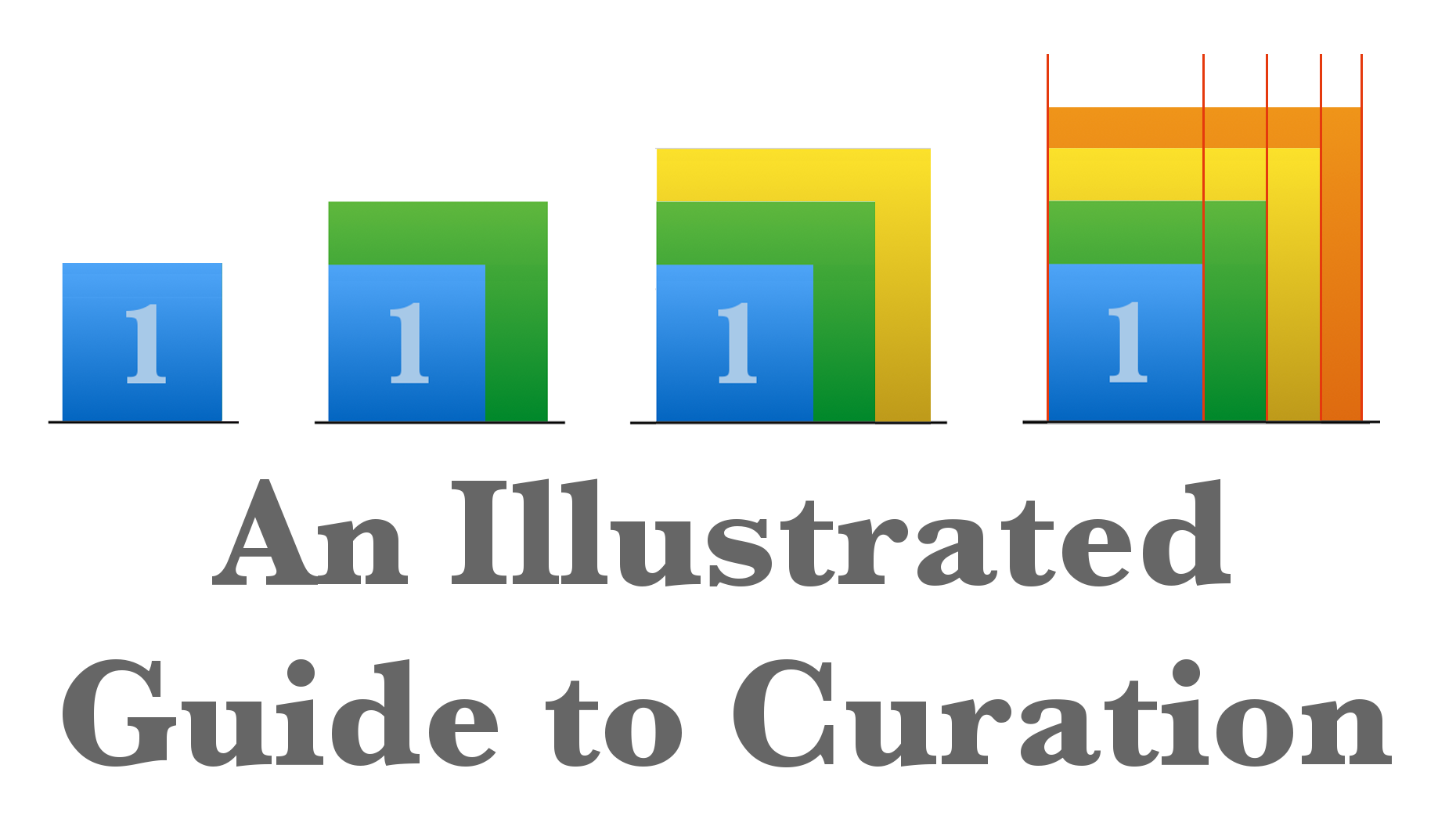
Curation rewards are a simple idea. But beneath the surface lie a multitude of complexities. In this series of posts we use illustrations and examples from past posts in an attempt to lay those complexities bare.
In part 1 we cover the basics, including a novel way to visualise each upvoter’s share of curation rewards. We also reveal why the percentage of rewards given to curators is not close to 25% of post payouts. And we explain how authors actually receive curation rewards from upvotes made after thirty minutes.
The Basics of Curation
Curation rewards exist to incentivise readers to seek out quality new content and to promote it with their upvotes. A proportion of the rewards from each post is reserved to pay for this curation. The currently split of rewards is 75% of the post payout for authors and 25% for curators. The overall curation payments are thus higher for more successful posts, rewarding curators who find quality content.
Curation rewards are also higher for early curators than for late curators, rewarding readers that take the time to unearth new content. However, for curation undertaken in the first thirty minutes after an article is posted, a proportion of the curation reward is returned to the author. This aims to prevent an immediate rush of curation on well-known authors. The proportion returned to the author decreases linearly, from 100% immediately after posting, through 50% of the curation rewards for an upvote at 15 minutes, reaching 0% at thirty minutes and for any upvote thereafter.
Curation rewards are always made in Steem Power (SP). This differs from author payouts which may be either fully powered-up, so 100% rewarded in Steem Power, or a 50/50 split between Steem Power and Steem Based Dollars (SBD).
In the simplest possible example, a post which receives a single $4.00 upvote after 30 minutes results in a $3.00 author reward and a $1.00 curation reward for the upvoter. Under the 50/50 SP/SBD author payout option this translates to the payouts below.
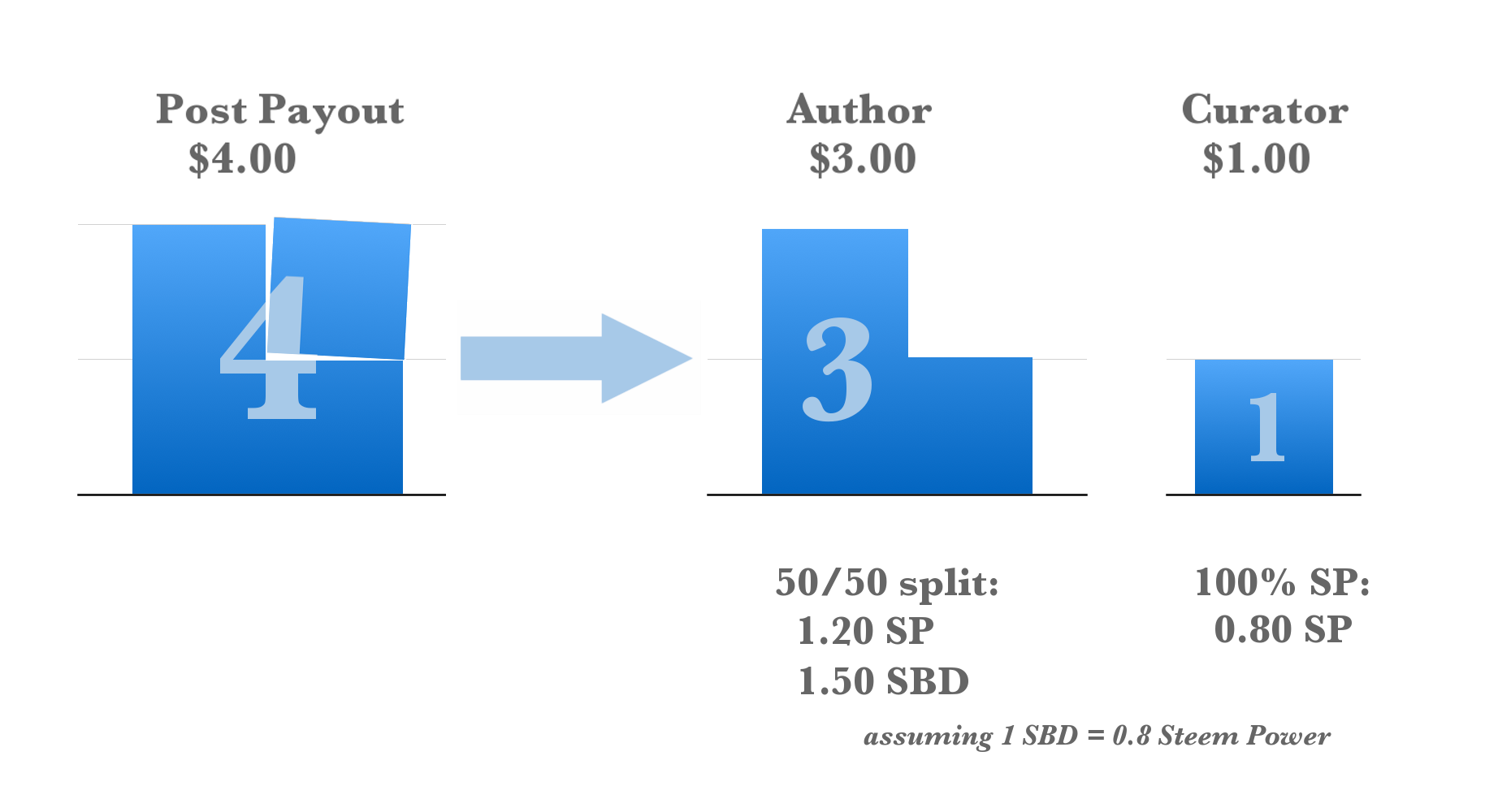
(in all examples we ignore any price / reward pool movements over the week that could increase or decrease the post value after an up vote is made)
Under the same example, but with the upvote made after 15 minutes, 50% of the curation reward is returned to the author, resulting in the following payouts:
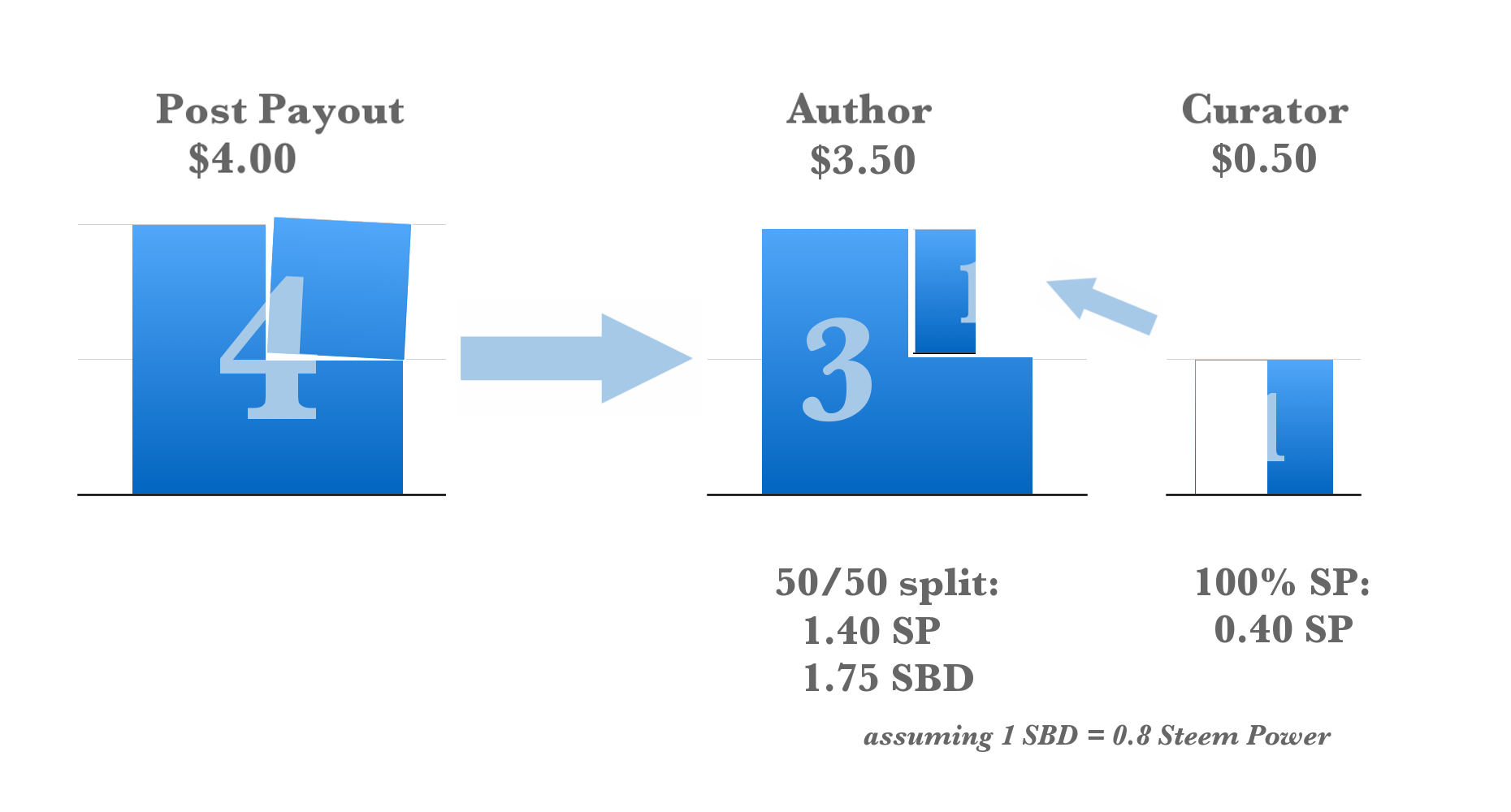
Depending on the size and timing of upvotes in the first thirty minutes, the total curation rewards on a post can vary between 0% and 25% of the overall post payout. Here are a couple of examples from past posts:
For this first post by @crema, no upvote was received in the first 30 minutes. The curator payout of $1.37 is exactly 25% of the post payout of $5.48. This example, with the full 25.0% obtained by curators, is actually quite rare.

For this second post by @fivestargroup, a huge whale upvote was received after six minutes, donating a large proportion of the curation rewards to the author. The curator payout of $6.37 is around 6% of the Post Payout of $105.49. This situation is more common, although this example is at the extreme end of the spectrum.

To give an idea of how curation reward percentages on posts vary, the chart below captures the curator rewards expressed as a percentage of the post payout for all posts on a single day in October. The figures have been rounded to the nearest percentage. Only posts where the author payout exceeds $1.00 have been included.
The average percentage is approximately 18% (by a count of posts, not weighted by post payout) so significantly less than 25%. Most posts receive some upvotes within the first thirty minutes, often from curators but also from the author themselves.
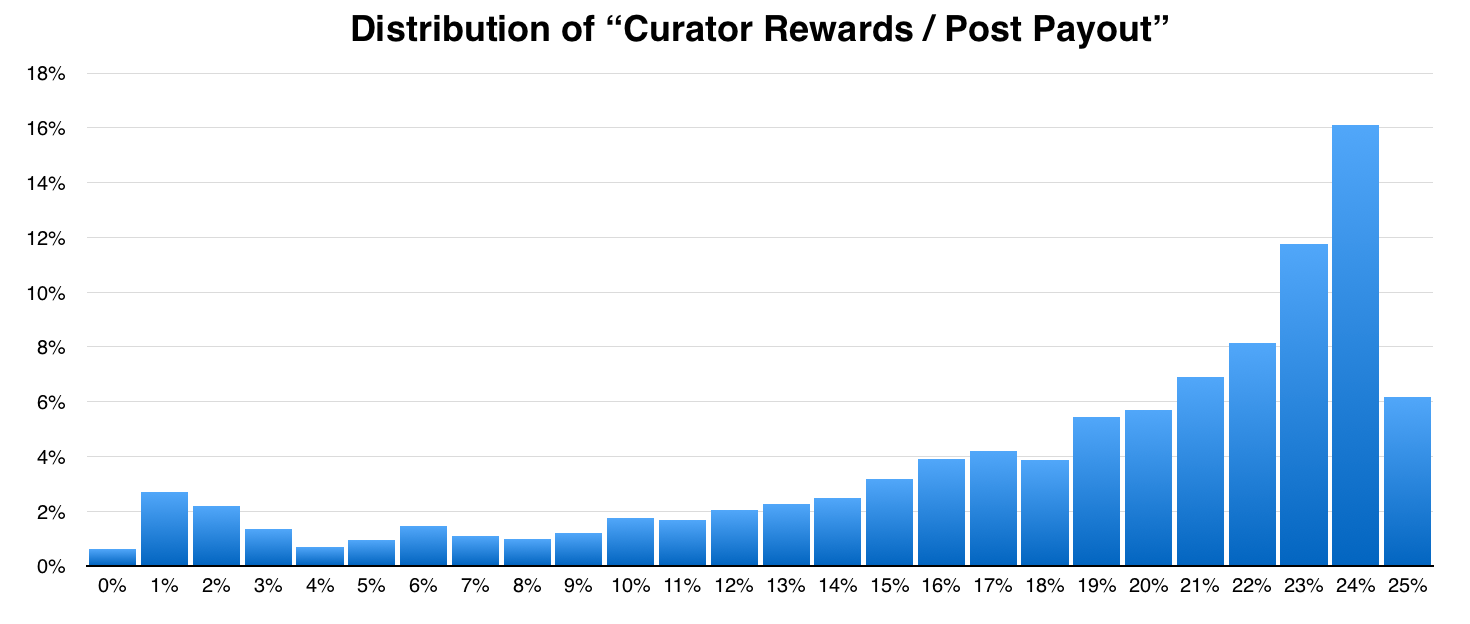
How the Curation Mechanism Rewards Early Upvoters
The order of upvotes makes no difference to the overall post payout. It does not matter who votes first, whether small votes are made before larger ones or vice versa. The upvotes simply add to the post payout, one on top of the other.
If we ignore the complication of the first thirty minutes, the author and total curator reward amounts are also unaffected by the order and timing of upvotes. However the order of upvotes is critical in determining the split of curation rewards between upvoters. The mechanism is designed to reward early curators who take the time to unearth new content.
The curation “weights”, i.e. the proportion of the total curation payout received by each curator, are calculated based on a square root function. The “weight” given to the first upvoter is the square root of the rshares added to the post by that curator’s upvote, where the rshares can be considered as a measure of the size of the upvote made. The “weight” given to the second upvoter represents their addition to the square root of the total rshares on the post, i.e:
curation weight of second voter =
√(rshares added by first voter + rshares added by second voter) - √(rshares added by first voter)
If there were no square root function applied then the curation reward weight for each curator would be in proportion to the size of their upvote. The timing of upvotes would also become irrelevant. The square root function has a lower impact on small numbers; for example compare SQRT(4) = 2, an impact of 2, and SQRT(81) = 9, an impact of 72. The function achieves its purpose by having a small impact on weights when the overall post payout is small and a larger impact on weights when the post payout has increased. This acts to increase curator rewards for early voters.
In this second example we have two upvotes, both of $4.00, the first made 30 minutes after the article was posted, the second one hour later. For simplicity the curation weights have been reduced down proportionately to the size of the curation payments; this does not impact the calculations.
The post payout is $8.00 resulting in a $6.00 author reward and a $2.00 overall curation reward. As can be seen in the illustration, the first upvoter receives a $1.41 curation reward, around two and a half times as much as the $0.59 received by the second upvoter.
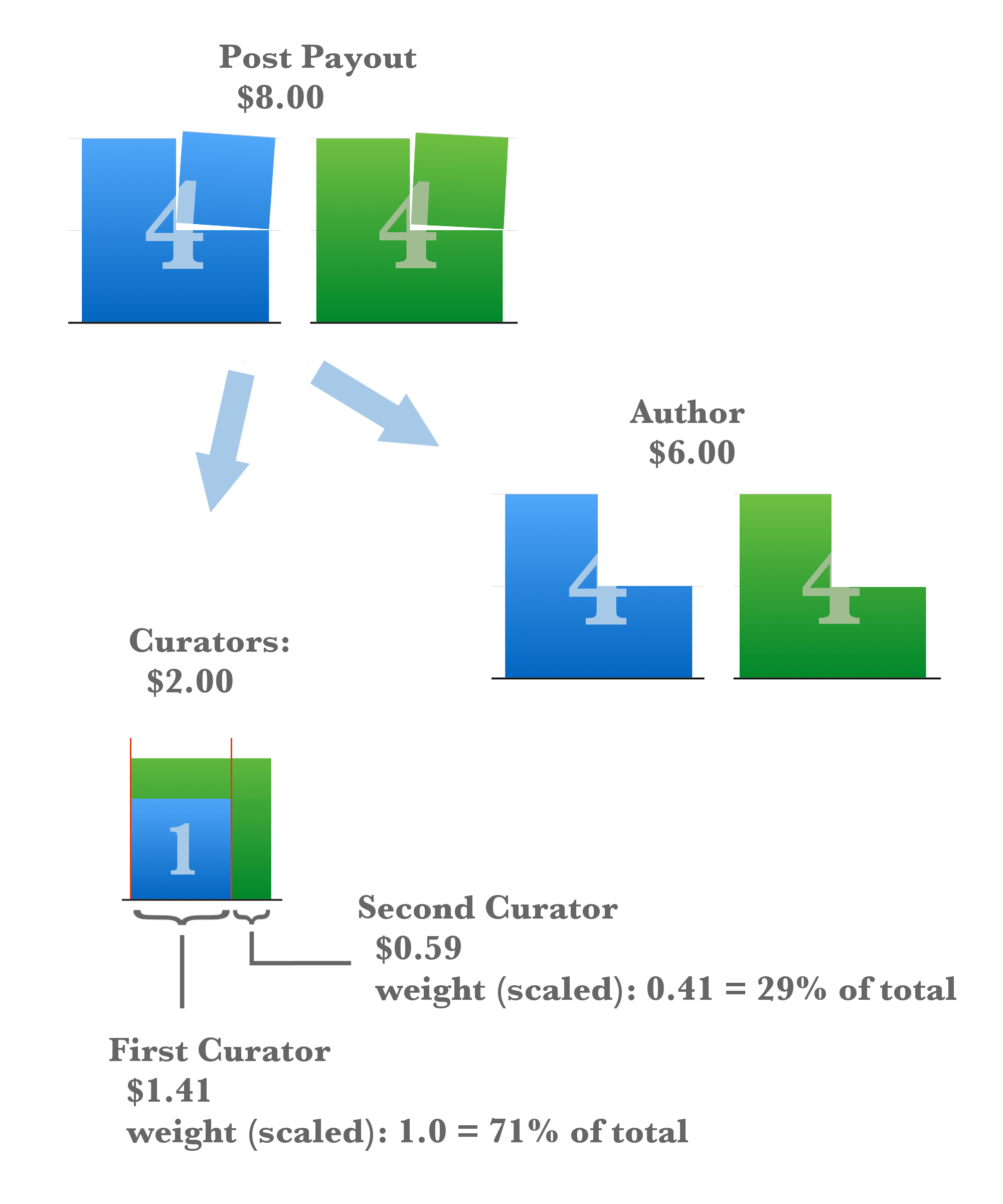
The relationship between the curation payments and the weights is represented visually at the bottom of the above illustration. The overall curation payment of $2.00 is the total area covered by the blue square and green angle shape combined (both green and blue areas are equal at $1.00). The curation weights are represented by the distance along the x-axis (√1 = 1.00 for the first curator; √2 - √1 = 0.41 for the second curator). The curation payments are represented by the vertical area above the x-axis, so the blue and green area between the red lines for the first curator (weight 1.00 x height 1.41 = $1.41); the completely green area remaining for the second curator (weight 0.41 x height 1.41 = $0.59).
Expressed more simply, what we can see is that the first curator gains almost half of the curation rewards added to the post by the upvote of the second curator (almost half of the green area sits above the blue square).
Under the same example, but with the first upvote made after 15 minutes rather than 30 minutes, 50% of the first upvoter's curation reward is returned to the author. Note that even though the timing of the second upvote is unchanged at 1hr30 minutes, a proportion of the curation rewards added to the post by the second upvoter is returned to the author. It can be considered as being passed from the second curator to the first curator through the square root function and then from the first curator to the author through the 30 minute rule. The second upvoter’s curation rewards are unchanged between these two situations, the question is whether the curation rewards they add remain with the first curator or are passed to the author.
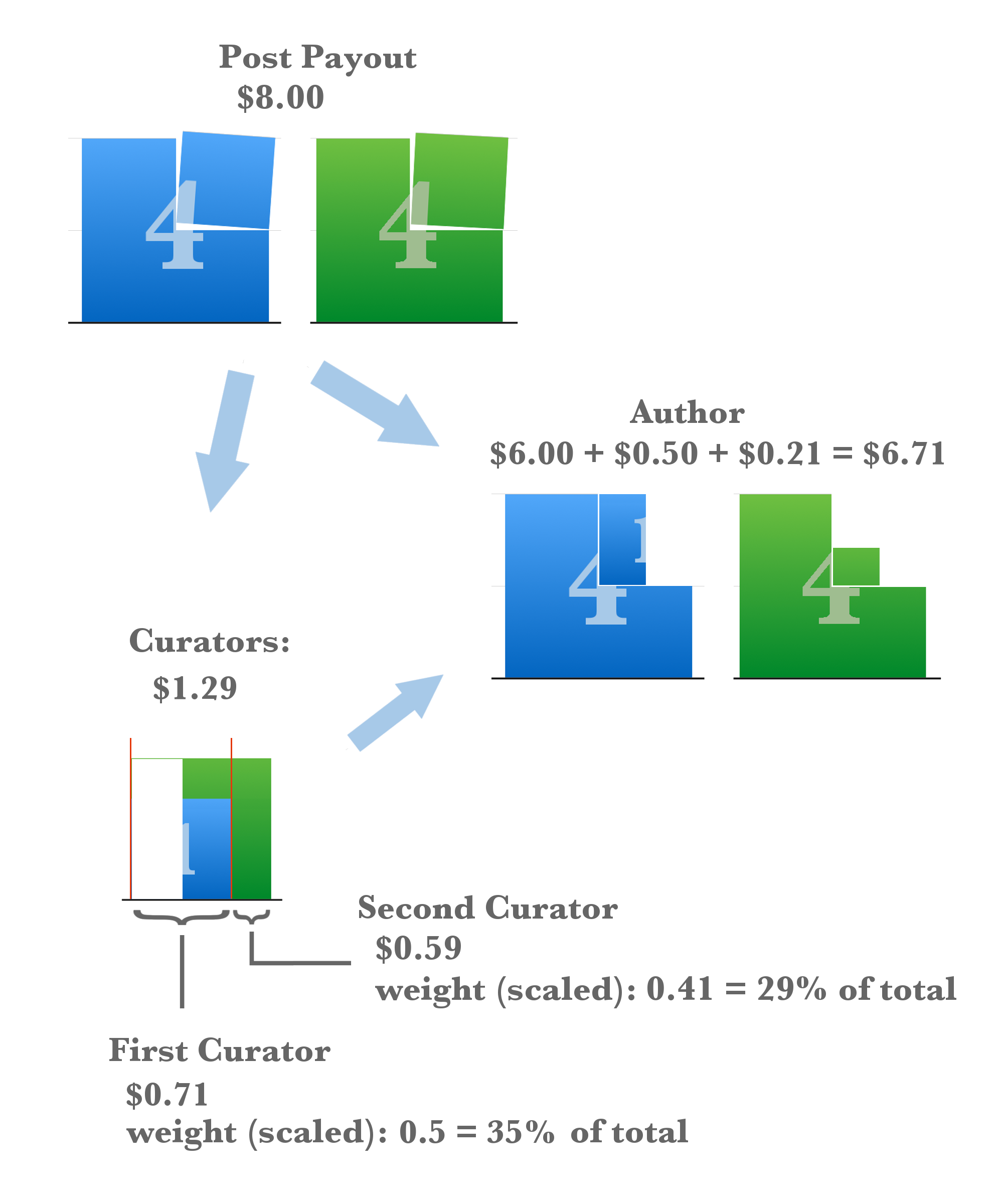
We can expand this theory to multiple curators and observe the same behaviour. This third example is based on four upvotes of $4.00 made at thirty minute intervals after the article was posted. The illustration below shows how the curation rewards build up with each upvote. Note that the weights along the x-axis do not need to be recalculated with each upvote, they simply form a smaller proportion of the total weight each time an upvote is added.
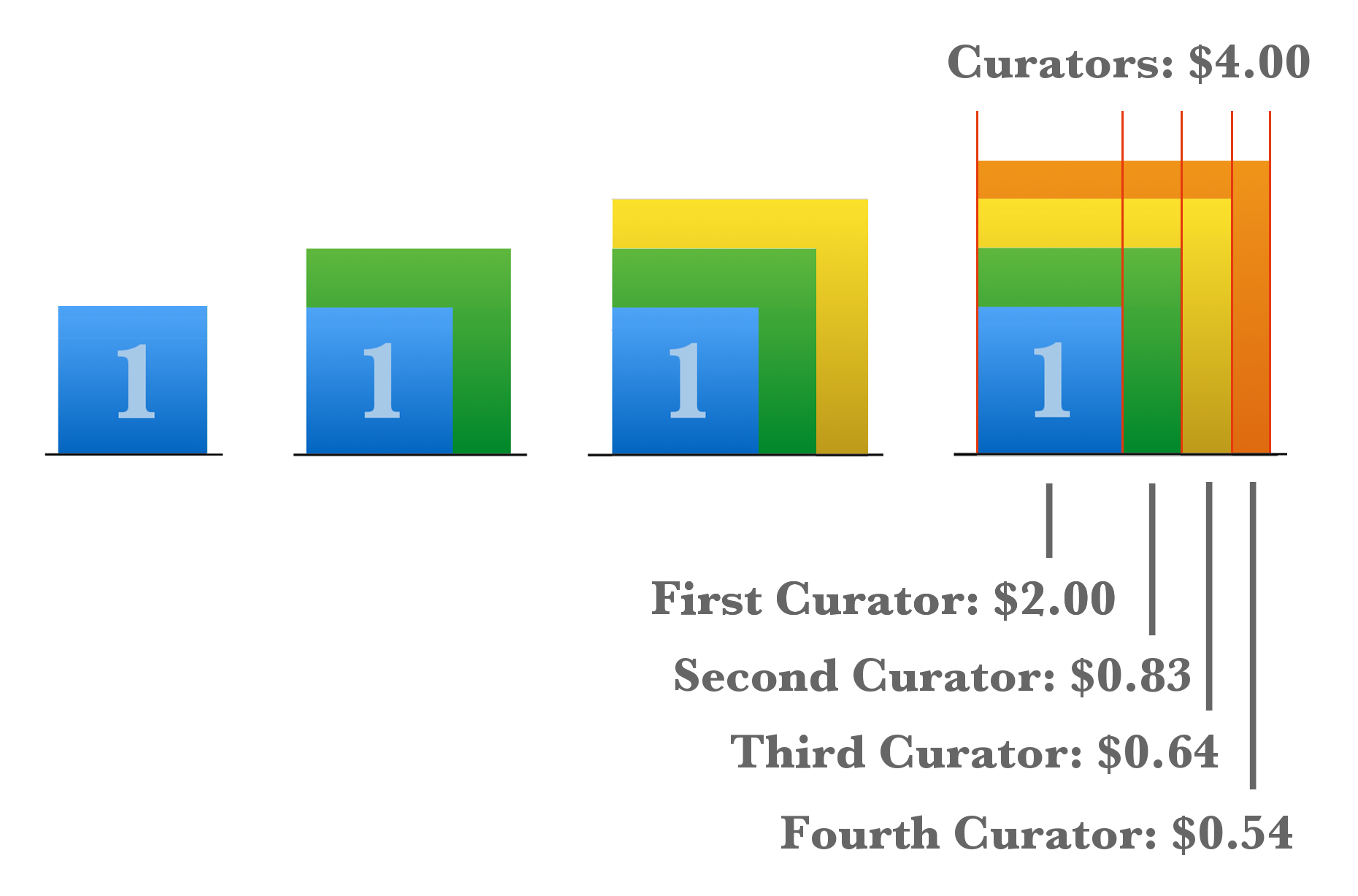
From the illustration above we can see that:
- Each new upvoter provides some curation rewards to all previous curators.
- The curation rewards for the first upvoter have doubled from $1.00 to $2.00 since our first example (while the post payout has increased by 4x).
- The curation rewards for each new upvoter decrease. Later curators receive close to the minimum limit. This is half of the curation rewards added by the upvoter (i.e. $0.50, half of $1.00).
- If we were to change the time of the first upvote to 15 minutes the author would receive a portion of the curation rewards added by the upvotes of all curators (passed through the curation rewards of the first upvoter).
It is worth noting that it is not the number of previous upvoters that is important in determining the split of curation rewards but the amount of the upvotes added. It would make no difference to the curation rewards of the fourth upvoter if there had been one previous upvote of $12.00 rather than three previous upvotes of $4.00.
To finish we look at a real life example. Five curators, the first being the author with a very small upvote at t=0. A second upvote of $1.48 by @floridasnail after 2 minutes and a third of $4.88 by @bramd much later. Other upvotes are small (but no doubt very welcome!)
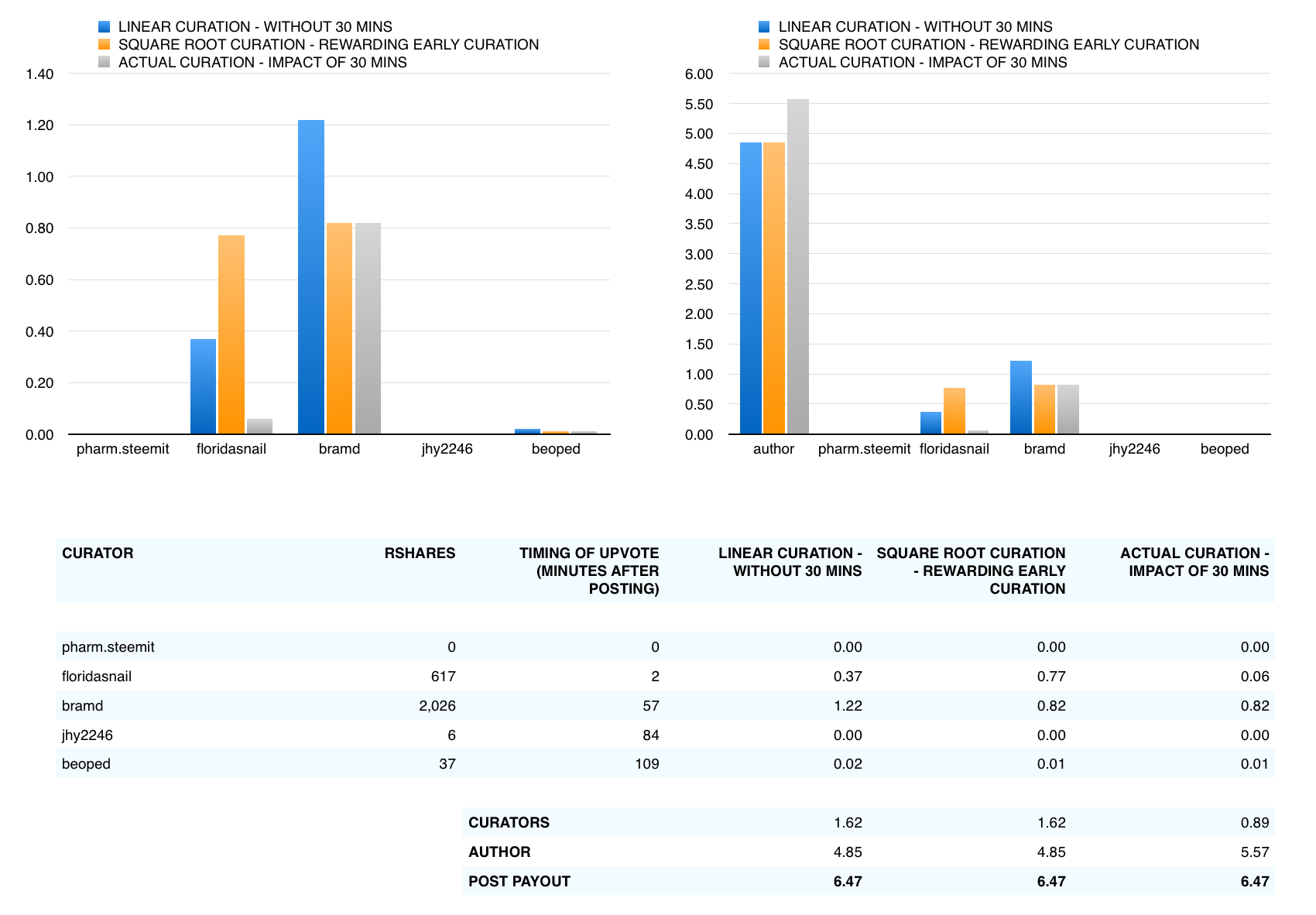
The charts show three different curation methods.
- In blue: Linear curation with no 30 minute rule - i.e. curation rewards in line with upvote size.
- In orange: Square root curation to show the impact of rewarding early curation.
- In grey: Square root curation but also showing the impact of adding the thirty minute rule.
As can be seen in blue, @bramd makes the largest upvote and under linear curation would receive the largest curation reward. In orange we see that under square root curation @floridasnail receives almost the same curation reward as @bramd due to voting earlier, even though their upvote was one quarter the size. In grey we see that almost all of @floridasnail’s curation rewards are passed to the author as @floridasnail upvoted after 2 minutes.
On the right hand chart we can see that the author receives $0.72 of curation rewards. All of this comes from @floridasnail’s square root curation rewards (which reduce from $0.77 in orange to $0.06 in grey once we add in the thirty minute rule). However, @floridasnail has obtained $0.35 of this $0.72 from the upvote made by @bramd. Looked at another way, the author receives $4.03 from the upvote made by @bramd, so 83% of the upvote rather than 75%. This demonstrates that a proportion of curation rewards added by upvotes made after thirty minutes can still flow to the author.
That’s all for part 1. In part 2 we will explain why most upvotes receive close to the minimum level of curation rewards and use real examples to examine how feasible it is to receive more than your upvote value in curation rewards. We also reveal why you may not be aware of the most valuable curation you undertake.

